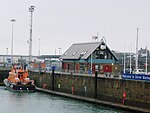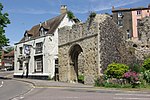HMS Glatton (1914)

HMS Glatton and her sister ship Gorgon were originally built as coastal defence ships for the Royal Norwegian Navy, as Bjørgvin and Nidaros respectively. She was requisitioned from Norway at the beginning of World War I, but was not completed until 1918 although she had been launched over three years earlier. On 16 September 1918, before she had even gone into action, she suffered a large fire in one of her 6-inch magazines, and had to be scuttled to prevent an explosion of her main magazines that would have devastated Dover. Her wreck was partially salvaged in 1926, and moved into a position in the northeastern end of the harbour where it would not obstruct traffic. It was subsequently buried by landfill underneath the current car ferry terminal.
Excerpt from the Wikipedia article HMS Glatton (1914) (License: CC BY-SA 3.0, Authors, Images).HMS Glatton (1914)
New Marina Curve Road,
Geographical coordinates (GPS) Address Nearby Places Show on map
Geographical coordinates (GPS)
| Latitude | Longitude |
|---|---|
| N 51.117 ° | E 1.315 ° |
Address
New Marina Curve Road
CT17 9FJ , Clarendon
England, United Kingdom
Open on Google Maps










